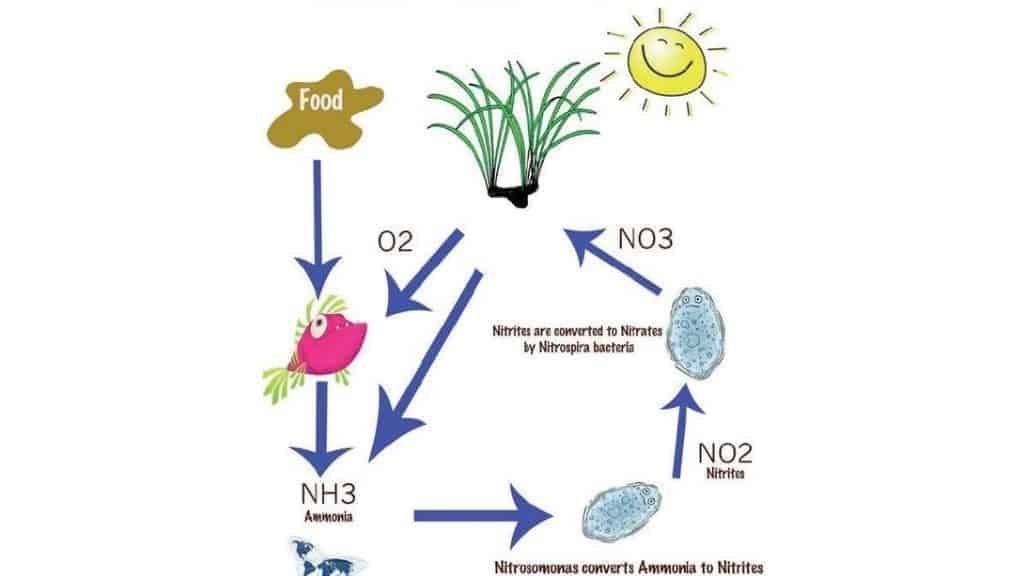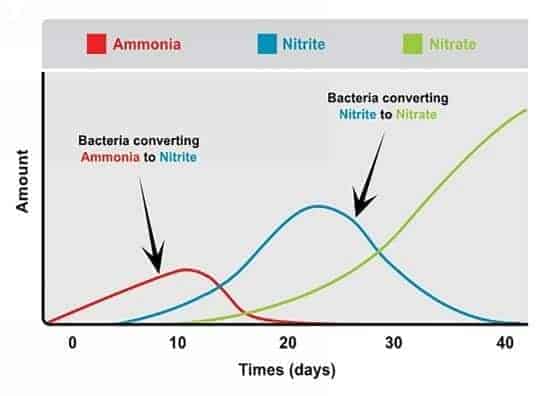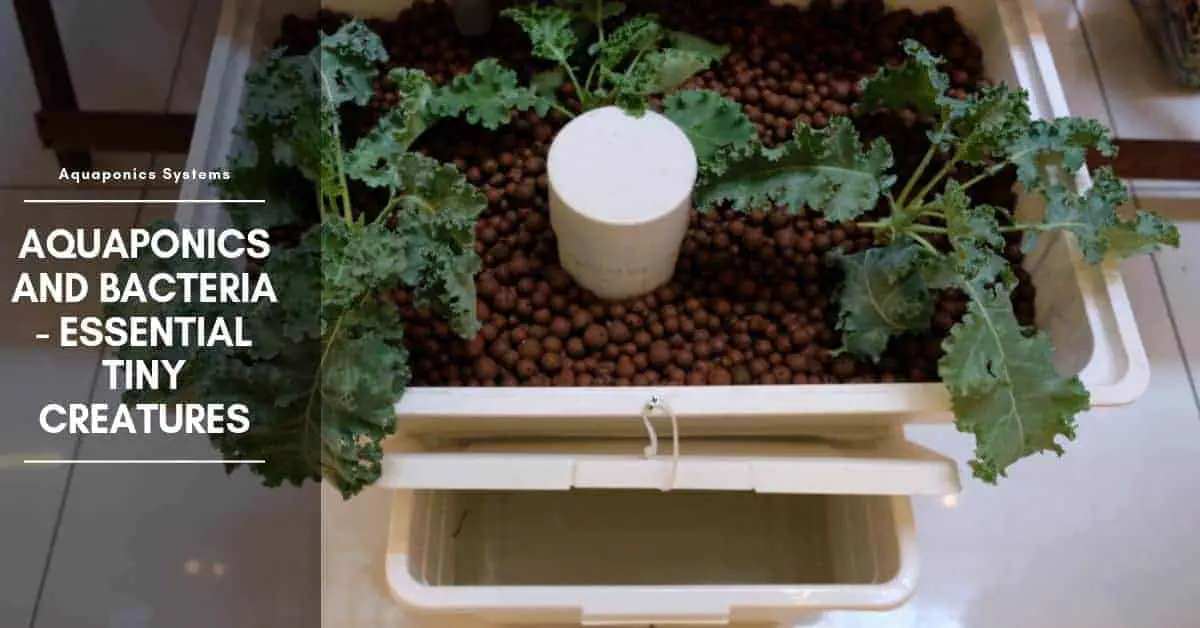Aquaponics relies heavily on the work of nitrifying bacteria in order to prevent fish waste from reaching toxic levels. Bacteria, therefore, forms a vital link between the components of the aquaponic ecosystem, making it possible for plants to effectively filter water in the system.
There are three main groups of bacteria which are necessary for the functioning of an aquaponic system, and which are often referred to as the “biofilter”:
- Ammonia-oxidizing bacteria, converting toxic ammonia into nitrites;
- Nitrite-oxidizing bacteria, which convert nitrites into nitrates, the most available form of nutrients for plants;
- Heterotrophic bacteria, which break down solid fish and plant wastes into available micro-nutrients, which are also necessary for plant growth.
Although all three groups of bacteria are vital for the functioning of an aquaponic system, the main focus is the bacteria which deal with ammonia and nitrogen. The ammonia-oxidizing and nitrite-oxidizing bacteria are referred to together as nitrifying bacteria and are the difference between the life and death of an aquaponic system. Without these bacteria, systems will quickly become toxic, resulting in mass fish deaths.
Additionally, healthy colonies of nitrifying and heterotrophic bacteria prevent the growth of less beneficial bacteria, which may infect plants or fish, and cause harm to the system, upsetting the vital balance of the system components.

How to Grow Nitrifying Bacteria?
It is very important to create an environment in your aquaponic system which is bacteria-friendly and will encourage the growth of a healthy bacterial colony. This encourages nitrifying and heterotrophic bacteria, which have similar environmental requirements, to reproduce in the system.
Environmental requirements
Both nitrifying and heterotrophic bacteria require the following elements.
A water temperature of between 60-85F (15-30C)
Bacteria will survive at temperatures outside of this range, but their reproduction and productivity decrease. Therefore, it is particularly important to monitor ammonia levels in the colder months, even in established aquaponic units, as it is not uncommon for low temperatures to inhibit bacterial activity, resulting in system toxicity.
A water pH of 6-7.5
Not too high or low, otherwise your living environment will not be pleasant for the bacteria, plants, and fishes.
Protection from sunlight
Nitrifying bacteria are photosensitive, so protection from UV light is important. Media beds offer natural protection, but care needs to be taken in systems that incorporate a biofilter to ensure that it is well-shaded. Additionally, sunlight leads to increased algae growth, which can inhibit bacterial function as well as clogging system components.
High oxygen levels
High levels of oxygen are required for nitrifying bacteria to thrive. Fortunately, fish and plants also prefer a well-oxygenated environment.
An additional advantage of providing an oxygen-rich environment is that it is disliked by the majority of unwanted bacteria which might otherwise colonize an aquaponic system, such as denitrifying bacteria and sulfate-reducing bacteria, both of which can create system conditions toxic to fish. Ensuring your system is rich in dissolved oxygen is one of the most reliable ways that you can ensure you are cultivating the right bacteria, not the unwanted kinds.
Biofilter requirements
A biofilter is a large tank which is intended to house the nitrifying bacteria in an aquaponic unit (heterotrophic bacteria will naturally colonize any areas where solid waste is found, such as the bottom of fish tanks, filters and grow beds). It is a requirement of NFT systems and is a useful addition to most aquaponic units.
The benefits of a biofilter are twofold: it provides a suitable habitat for nitrifying bacteria, allowing larger colonies than are possible solely in grow beds, thus making ammonia poisoning more unlikely; and it allows for extra water in the system, protecting fish and bacteria in the case of a plumbing malfunction.
API STRESS ZYME Freshwater and Saltwater Aquarium Cleaning Solution 16-Ounce Bottle
API ACCU-CLEAR Freshwater Aquarium Water Clarifier 4-Ounce Bottle
12% OffAPI GENERAL CURE Freshwater and Saltwater Fish Powder Medication 10-Count Box
15% OffA biofilter should provide the ideal habitat for nitrifying bacteria, so must be opaque and covered, in order to protect bacteria from sunlight. Biofilters should also be well-aerated, and it is not uncommon to situate an air-stone within.
Nitrifying bacteria will grow on any wet surface, so the primary purpose of a biofilter is to provide a large amount of surface area for the bacteria to colonize. This might comprise a tank filled with one of the aforementioned growing media (porous volcanic stone or expanded clay beads work particularly well), with weighted plastic or Styrofoam packing beads (large enough not to clog filters or enter the system), commercially produced “Bio-filter Balls” or even with bundles of a large-gauge plastic fencing or net material. Any material which provides space for bacteria colonies to grow will work.
Sourcing bacteria
Heterotrophic bacteria exist naturally everywhere and will populate a new aquaponic unit in sufficient numbers that sourcing them is unnecessary.
Nitrifying bacteria also exist naturally in water and air and will colonize a new aquaponic unit unassisted once system cycling is begun. However, many new aquaponic growers source nitrifying bacteria externally. Keep in mind that bacteria colonies are not made, they grow. Therefore, sourcing nitrifying bacteria externally merely hastens the process of system cycling somewhat, it does not negate it.
Nitrifying bacteria can be sourced in two ways:
1. Aquaponic, aquaculture and aquarium stores sell various “liquid” forms of nitrifying bacteria.
2. Water or biofilter material from a mature and balanced aquaponic system, or even an aquarium, can be used as a source of nitrifying bacteria.
Of these options, bottled bacteria can help to establish a biofilter more rapidly, but is expensive and can be difficult to source. If it can be ascertained that material from an established system is disease-free, this is the best way to start system cycling. However, relying on natural and unassisted colonization is equally effective in the long term.
System Cycling
System cycling is the process of establishing a colony of nitrifying bacteria in an aquaponic unit. Even if bacteria are sourced from an aquaponics store or existing system, cycling will still be necessary in order to allow bacteria to colonize the new system in sufficient numbers to support fish.
Nitrifying bacteria reproduce relatively slowly, and therefore the process of system cycling can take anywhere between 2 weeks and 2 months, depending on the initial source of bacteria and environmental conditions such as temperature. Many beginning aquaponic growers become impatient, adding fish before the system cycling is complete. As there are insufficient nitrifying bacteria to process all of their waste, these fish will likely die and those that survive will be sickly and stunted from their prolonged exposure to high levels of ammonia and nitrite.
System cycling consists of gradually adding ammonia to a new aquaponic unit. The system is run, or the water cycled, as if the unit was complete and producing, even though there are no plants or fish. The addition of ammonia provides a food source for the nitrifying bacteria and encourages the establishment of a biofilter colony.
Sources of ammonia for system cycling
Various sources of ammonia can be used for system cycling. Options include the following.
Pure ammonia
In some countries, it is possible to purchase ammonia at hardware or chemists. Ammonia may also be available as a cleaner and can be used to system cycle provided it does not contain colorants, scents or other additives.
Fish food
Fresh fish food ground to a fine powder is an inexpensive ammonia source for cycling.
Biological sources
Animal manures and aged urine can be used as an ammonia source but should be sterilized to ensure that unwanted bacteria and pathogens are not introduced to the system.
Fish
Fish stocked at an extremely low density – 1-2 per 9 cubic feet (1-2 per m3) – can be used as an initial source of ammonia. Aquarium feeder fish (stocked at 5-10 per 9 cubic feet (5-10 per m3) due to their tiny size) are usually the best choice as fatalities are high and these fish are unlikely to ever thrive. However, this source makes it very difficult to control ammonia levels in the system and is not recommended.
How to system cycle
Once the aquaponic unit is running and water flow is established, a small amount of ammonia is added to the system each day. This ammonia provides a constant food source for the nitrifying bacteria and encourages reproduction and the establishment of colonies.
When adding ammonia initially, the goal is to establish and maintain a system-wide ammonia level of less than a two-hundredth of a percent (0.005%). Levels significantly higher than this will be toxic even to nitrifying bacteria and require the immediate dilution of water in the system.
Note that even pure ammonia is available in different strengths, so the amount added to the system will depend on the water volume of your unit as well as the concentration of your ammonia source. The following equation can be used to calculate the amount of ammonia to be added daily:

In a cycling system, ammonia-oxidizing bacteria will colonize the biofilter in the first week, causing an increase of nitrite in the water. After another week or so, the system will show both nitrites and nitrates, as colonies of nitrite-oxidizing bacteria become established.

When the system has ammonia and nitrite levels of less than 0.00005 ounces per quart (1-2 mg per liter) – essentially, ammonia levels so low as to be immeasurable – the system cycling process is complete. Bacteria colonies are established and the system is ready for the addition of plants and fish.
Adding plants and fish
Although they are unlikely to thrive, plants can be added to an aquaponic system prior to the end of system cycling. Fish, on the other hand, should only be added once cycling is complete.
If you have completed the system cycling process but are not yet ready to add fish, a stable level of ammonia should be added to the system daily as when cycling. If this is neglected, your painstakingly cultivated bacteria colonies will quickly starve to death and you will have to begin the process again.
Fish should be added gradually to a new aquaponic unit, a couple at a time. Even in small numbers, fish are likely to produce more ammonia than the bacteria colonies are accustomed to processing. It will make the system a few days to re-establish equilibrium and bring ammonia and nitrite levels back to below 0.00005 ounces per quarter (1mg per liter) once of fish that have been added.
Monitoring bacteria
Although a brownish slime in the biofilter or on other system surfaces is indicative of nitrifying bacteria, it is impossible to actually measure the population of the colonies successfully on a home scale. Instead, bacteria are monitored through measurements of ammonia, nitrites, and nitrates.
Nitrites and nitrates will only be present in an aquaponic system through the functioning of nitrifying bacteria, and if a stable ammonia and nitrite level of below 0.00005 ounces per quart (1mg per liter) is maintained, it can be safely assumed that the bacteria in your system is healthy and happy.

Hi, my name is Sean, and I’m the primary writer on the site. I’m blogging mostly about freshwater and saltwater aquariums, fish, invertebrates, and plants. I’m experienced in the fishkeeping hobby for many years. Over the years I have kept many tanks, and have recently begun getting more serious in wanting to become a professional aquarist. All my knowledge comes from experience and reading forums and a lot of informative sites. In pursuit of becoming a professional, I also want to inspire as many people as I can to pick up this hobby and keep the public interest growing.
Read more about Sean.
Please join also my Facebook group.















